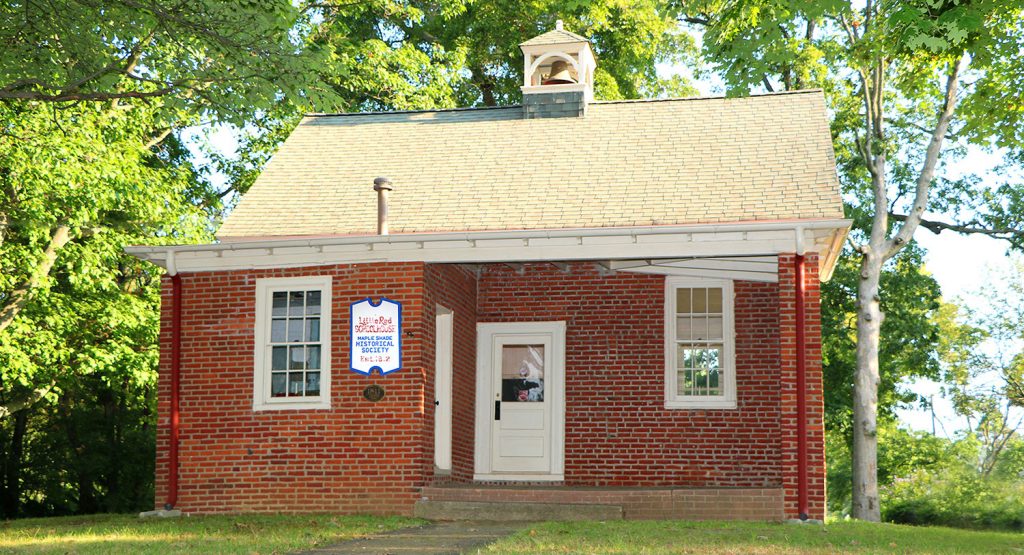Town History
Town History
This Page Still Under Construction – Come Back Soon!
Maple Shade Township was first settled by the Roberts family in 1682 and developed in the early years, before the independence of the colonies, as primarily agricultural.
For its first one hundred years, only Kings Highway served the area, providing poor travel, and residents chose travel by boat rather than overland as a result, until 1794 when the road that was to be Main Street was constructed to connect Kings Highway with the Cooper River ferry. Afterwards, new settlers and the families of the original settlers encouraged the division and sharing of the large plantations into smaller holdings, still agricultural in nature.
The Settlement became more firmly established as a community in 1811, when the property was set aside by Joseph Burrough for the construction of a one-room brick school house, now known as the Little Red Schoolhouse, on Main Street, just west of Coles Avenue. The school served the residents of the Township for 97 years, closing in 1909.

The Settlement became more firmly established as a community in 1811, when the property was set aside by Joseph Burrough for the construction of a one-room brick school house, now known as the Little Red Schoolhouse, on Main Street, just west of Coles Avenue. The school served the residents of the Township for 97 years, closing in 1909.
About the time of the establishment of the schoolhouse, a sawmill was built on the Pennsauken Creek where Mill Road now crosses Route 38.
In 1847 a blacksmith shop and wagon works, constructed on the south side of Main Street just west of Spruce Avenue, operated until it was destroyed by fire in 1939.
As in many settlements in the country, the coming of the railroad right-of-way purchased in 1864 and placed in operation in 1867 – brought identity to the area in the form of a station and a rail stop. The railroad also changed the complexion of the community, giving it the potential to have single family residents commuting by rail to employment outside of the Township.
The railroad also brought other businesses and industry including brick making in 1867, butchering and meat processing, as well as clothing manufacturing in 1883.
As the population grew, so did the community. Naturally, the establishment of churches followed, beginning in 1888 with the Episcopal congregation and adding through the years, Roman Catholic, Congregational, Baptist, Lutheran, and Jehovah’s Witness congregations.
With the establishment of the community came the demand for public services which, in turn, required the creation of provisions to govern the methods of offering public service, the types of service to be offered to the community, and their future maintenance.
The demand for a public water source let to the first water works in 1893; telephones in 1893; a local post office in 1887; and the first police officer in 1911. The first fire company formed in 1899, and it received its first hand pump in 1912.
Following the closing of the Little Red Schoolhouse in 1909, in that year, a new two-room facility was opened on North Poplar Avenue. A second school was built in 1920 on Chestnut Avenue and, ultimately, two more grade schools and a high school.
The community was known as Chester Township, and existed essentially as a neighborhood of Moorestown Township. In 1922, the residents of Chester Township voted to separate from Moorestown, electing a Township Committee. The first Municipal Building on Main Street was completed in 1927, and in it was placed the first public library in 1930. In 1945, the community chose to become Maple Shade Township.
The Committee form of government continued from 1922 until 1975, when the Township chose by referendum to adopt the Council-Manager (Faulkner Act) form of government under which the government presently operates in its new facilities, opened in 1992, at 200 Stiles Avenue.
Long established and recognized as a community, Maple Shade Township has retained a strong business presence with light industrial and commercial centers, in addition to having an identity which is suburban within the Philadelphia metropolitan area.
The result is a broad spectrum of local and regional amenities available to Maple Shade residents with a strong sense of common interest and community individuality.
